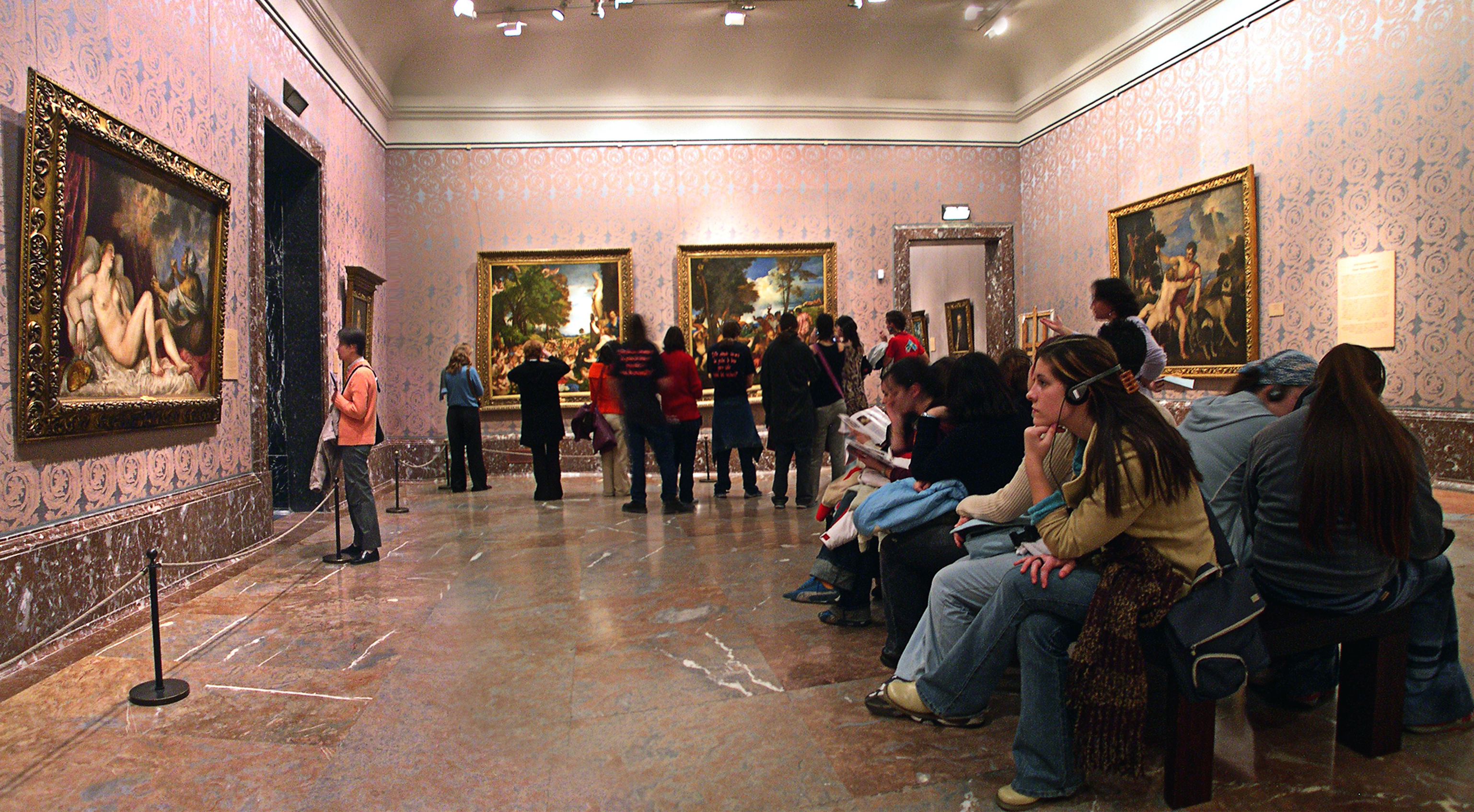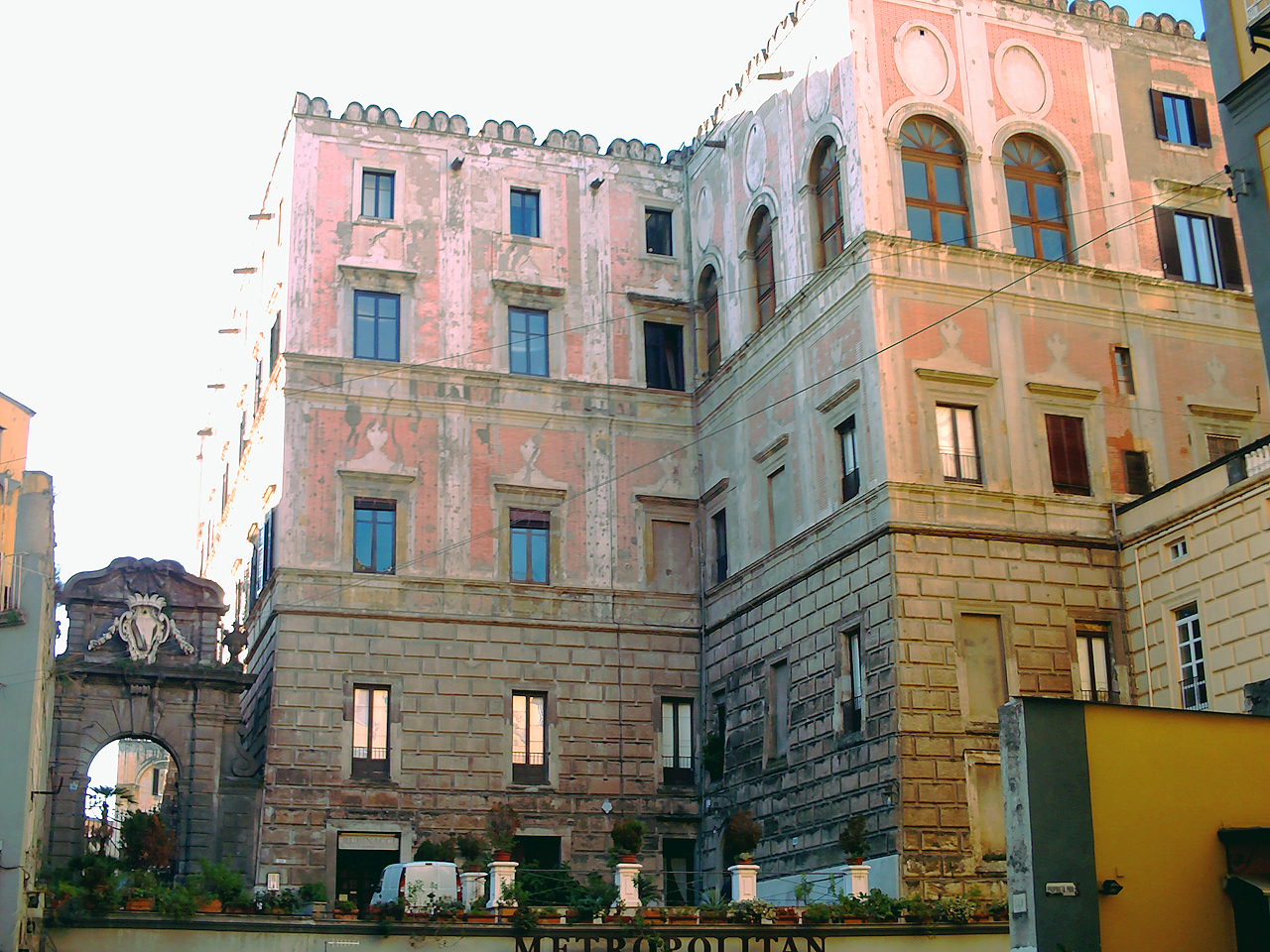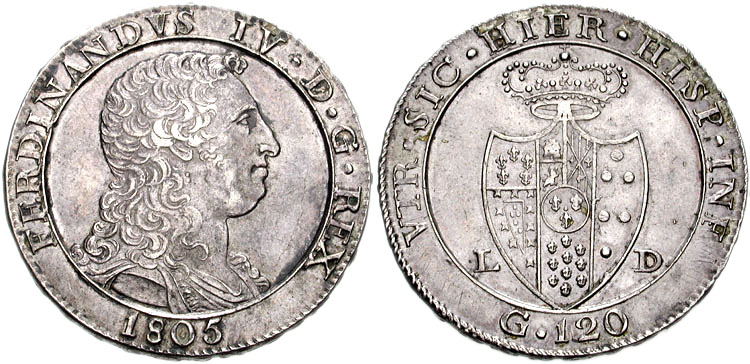|
Portrait Of Cardinal Alessandro Farnese (Titian)
''Portrait of Cardinal Alessandro Farnese'' is a oil on canvas three-quarter-length portrait of Alessandro Farnese the Younger (1520-1589) by Titian, now in the Museo nazionale di Capodimonte in Naples. AA. VV., ''Tiziano e il ritratto di corte da Raffaello ai Carracci'', Napoli, Editrice Electa, 2006, ISBN 978-8851003364, p 152 Its subject is shown in front of a green curtain, wearing a cardinal's robes and holding gloves in his right hand (an accessory more usual in portraits of gentlemen and noblemen than of clerics). Museo di Capodimonte', Touring Club Italiano, 2004, p. 28 His depiction here is similar to that in '' Pope Paul III and His Grandsons'', placing the two works close together in date. History No surviving sources mention how, when or by whom the work was commissioned. Its subject was a major patron of the arts and the main intermediary between Titian and the Farnese family, first commissioning '' Portrait of Ranuccio Farnese'' from him, showing Alessandro's yo ... [...More Info...] [...Related Items...] OR: [Wikipedia] [Google] [Baidu] |
Titian
Tiziano Vecelli or Vecellio (; 27 August 1576), known in English as Titian ( ), was an Italians, Italian (Republic of Venice, Venetian) painter of the Renaissance, considered the most important member of the 16th-century Venetian school (art), Venetian school. He was born in Pieve di Cadore, near Belluno. During his lifetime he was often called ''da Cadore'', 'from Cadore', taken from his native region. Recognized by his contemporaries as "The Sun Amidst Small Stars" (recalling the final line of Dante Alighieri, Dante's ''Paradiso (Dante), Paradiso''), Titian was one of the most versatile of Italian painters, equally adept with portraits, landscape backgrounds, and mythological and religious subjects. His painting methods, particularly in the application and use of colour, exercised a profound influence not only on painters of the late Italian Renaissance, but on future generations of Art of Europe, Western artists. His career was successful from the start, and he became sought ... [...More Info...] [...Related Items...] OR: [Wikipedia] [Google] [Baidu] |
Palazzo Della Pilotta
The Palazzo della Pilotta is a complex of edifices located between Piazzale della Pace and the Lungoparma in the historical centre of Parma, region of Emilia Romagna, Italy. Its name derives from the game of pelota played at one time by Spanish soldiers stationed in Parma. History Built around 1583, during the last years of reign of Duke Ottavio Farnese, it developed around the corridor (''Corridore'') which connected the keep (''Rocchetta'', traces of which can be seen next the river Parma) to the Ducal Palace: the latter, begun in 1622 under Duke Ranuccio I, was never completed. the façade on the ''Piazza della Ghiaia'' is missing and the annexed Dominican church of St. Peter was demolished only in recent times. The existing complex includes three courts: the ''Cortile di San Pietro Martire'' (now best known as ''Cortile della Pilotta''), ''Cortile del Guazzatoio'' (originally ''della pelota'') and the ''Cortile della Racchetta''. The Pilotta was to house a large hall, later ... [...More Info...] [...Related Items...] OR: [Wikipedia] [Google] [Baidu] |
Portraits By Titian
A portrait is a painting, photograph, sculpture, or other artistic representation of a person, in which the face and its expressions are predominant. The intent is to display the likeness, personality, and even the mood of the person. For this reason, in photography a portrait is generally not a snapshot, but a composed image of a person in a still position. A portrait often shows a person looking directly at the painter or photographer, in order to most successfully engage the subject with the viewer. History Prehistorical portraiture Plastered human skulls were reconstructed human skulls that were made in the ancient Levant between 9000 and 6000 BC in the Pre-Pottery Neolithic B period. They represent some of the oldest forms of art in the Middle East and demonstrate that the prehistoric population took great care in burying their ancestors below their homes. The skulls denote some of the earliest sculptural examples of portraiture in the history of art. Historical portraitur ... [...More Info...] [...Related Items...] OR: [Wikipedia] [Google] [Baidu] |
List Of Works By Titian
This incomplete list of works by Titian contains representative portraits and mythological and religious works from a large oeuvre that spanned 70 years. (Titian left relatively few drawings.) Painting titles and dates often vary by source. List of works by year References {{Lists of paintings Lists of works of art, Titian Paintings by Titian, * Portraits by Titian, * ... [...More Info...] [...Related Items...] OR: [Wikipedia] [Google] [Baidu] |
National Archaeological Museum, Naples
The National Archaeological Museum of Naples ( it, Museo Archeologico Nazionale di Napoli, italic=no, sometimes abbreviated to MANN) is an important Italian archaeological museum, particularly for ancient Roman remains. Its collection includes works from Greek, Roman and Renaissance times, and especially Roman artifacts from the nearby Pompeii, Stabiae and Herculaneum sites. From 1816 to 1861, it was known as Real Museo Borbonico ("the Royal Bourbon Museum"). Building The building was built as a cavalry barracks in 1585. From 1616 to 1777 it was the seat of the University of Naples. During the 19th century, after it became a museum, it suffered many changes to the main structure. Collections The museum hosts extensive collections of Greek and Roman antiquities. Their core is from the Farnese Collection, which includes a collection of engraved gems (including the Farnese Cup, a Ptolemaic bowl made of sardonyx agate and the most famous piece in the "Treasure of the Magnificent" ... [...More Info...] [...Related Items...] OR: [Wikipedia] [Google] [Baidu] |
Palazzo Degli Studi (Naples)
A palace is a grand residence, especially a royal residence, or the home of a head of state or some other high-ranking dignitary, such as a bishop or archbishop. The word is derived from the Latin name palātium, for Palatine Hill in Rome which housed the Roman Empire, Imperial residences. Most European languages have a version of the term (''palais'', ''palazzo'', ''palacio'', etc.), and many use it for a wider range of buildings than English. In many parts of Europe, the equivalent term is also applied to large private houses in cities, especially of the aristocracy; often the term for a large country house is different. Many historic palaces are now put to other uses such as parliaments, museums, hotels, or office buildings. The word is also sometimes used to describe a lavishly ornate building used for public entertainment or exhibitions such as a movie palace. A palace is distinguished from a castle while the latter clearly is fortified or has the style of a fortification ... [...More Info...] [...Related Items...] OR: [Wikipedia] [Google] [Baidu] |
Palazzo Reale
This is a list of royal palaces, sorted by continent. Africa * Abdin Palace, Cairo * Al-Gawhara Palace, Cairo * Koubbeh Palace, Cairo * Tahra Palace, Cairo * Menelik Palace * Jubilee Palace * Guenete Leul Palace * Imperial Palace- Massawa Eritrea * Ludzidzini Royal Village * Lozitha Palace * Royal Palace Maseru * Royal Palace of Tripoli * Al Manar Palace * Dar al-Makhzen, Rabat * Dar al-Makhzen, Fez * Bahia Palace, Marrakech * Dar al-Makhzen, Tangier * El Badi Palace, Marrakech * Olowo of Owo's Palace * Alaafin of Oyo's Palace * Sultan of Sokoto's Palace * Nyanza Palace * Rwesero Palace * Sultan's Palace, Zanzibar * Bardo Palace, Tunis, now the national museum * Mengo Palace * Karuziika Palace * Kyabazinga Palace * Kabakas Palace Americas * Imperial Palace - Rio de Janeiro * Palace of São Cristóvão - Rio de Janeiro * Palace of Petrópolis - Petrópolis * Palace of Grão-Pará - Petrópolis * Palace of Santa Cruz - Rio de Janei ... [...More Info...] [...Related Items...] OR: [Wikipedia] [Google] [Baidu] |
Palermo
Palermo ( , ; scn, Palermu , locally also or ) is a city in southern Italy, the capital (political), capital of both the autonomous area, autonomous region of Sicily and the Metropolitan City of Palermo, the city's surrounding metropolitan province. The city is noted for its history, culture, architecture and gastronomy, playing an important role throughout much of its existence; it is over 2,700 years old. Palermo is in the northwest of the island of Sicily, by the Gulf of Palermo in the Tyrrhenian Sea. The city was founded in 734 BC by the Phoenicians as ("flower"). Palermo then became a possession of Carthage. Two ancient Greeks, Greek ancient Greek colonization, colonies were established, known collectively as ; the Carthaginians used this name on their coins after the 5th centuryBC. As , the town became part of the Roman Republic and Roman Empire, Empire for over a thousand years. From 831 to 1072 the city was under History of Islam in southern Italy, Arab ru ... [...More Info...] [...Related Items...] OR: [Wikipedia] [Google] [Baidu] |
Palazzo Cellammare
The Palazzo Cellamare or Cellammare is a monumental palace located in via Chiaia 139 in the Quartiere San Ferdinando of Naples, Italy. The entrance is near the church of Santa Caterina a Chiaia. History The palace was erected in the 16th century by Giovanni Francesco Carafa, Prince of Stigliano and a member of the House of Carafa. Giovanni Francesco's son Pier Luigi Carafa later commissioned Ferdinando Manlio to make the palace conform to the typical characteristics of its era. During the Masaniello revolt in 1647, the palace was sacked by mobs and in 1689 it became the property of the state. In the 18th century, it was acquired by the Prince of Cellamare, Antonio del Giudice, who hired Ferdinando Fuga to design the chapel between 1726 and 1727. It later became the residence of the Spanish Michele Imperiali Simeana, Prince of Montena and Francavilla (d. 1782), a friend of Casanova, and avid collector of statuary. The palace was briefly known as the ''Palazzo Francavilla''. ... [...More Info...] [...Related Items...] OR: [Wikipedia] [Google] [Baidu] |
Ferdinand I Of The Two Sicilies
Ferdinand I (12 January 1751 – 4 January 1825) was the King of the Two Sicilies from 1816, after his restoration following victory in the Napoleonic Wars. Before that he had been, since 1759, Ferdinand IV of the Kingdom of Naples and Ferdinand III of the Kingdom of Sicily. He was also King of Gozo. He was deposed twice from the throne of Naples: once by the revolutionary Parthenopean Republic for six months in 1799 and again by Napoleon in 1805, before being restored in 1816. Ferdinand was the third son of King Charles VII of Naples and V of Sicily by his wife, Maria Amalia of Saxony. On 10 August 1759, Charles succeeded his elder brother, Ferdinand VI, becoming King Charles III of Spain, but treaty provisions made him ineligible to hold all three crowns. On 6 October, he abdicated his Neapolitan and Sicilian titles in favour of his third son, because his eldest son Philip had been excluded from succession due to imbecility and his second son Charles was heir-apparent to the S ... [...More Info...] [...Related Items...] OR: [Wikipedia] [Google] [Baidu] |
Parthenopean Republic
The Parthenopean Republic ( it, Repubblica Partenopea, french: République Parthénopéenne) or Neapolitan Republic (''Repubblica Napoletana'') was a short-lived, semi-autonomous republic located within the Kingdom of Naples and supported by the French First Republic. The republic emerged during the French Revolutionary Wars after King Ferdinand IV fled before advancing French troops. The republic existed from 21 January to 13 June 1799, collapsing when Ferdinand returned to restore monarchial authority and forcibly subdued republican activities. Etymology The Parthenopean Republic is named after Parthenope, a Greek settlement now part of the city of Naples. Origins of the Republic On the outbreak of the French Revolution King Ferdinand IV of Naples and Queen Maria Carolina did not at first actively oppose reform; but after the fall of the French monarchy they became violently opposed to it, and in 1793 joined the first coalition against France, instituting severe persecution ... [...More Info...] [...Related Items...] OR: [Wikipedia] [Google] [Baidu] |
Charles III Of Spain
it, Carlo Sebastiano di Borbone e Farnese , house = Bourbon-Anjou , father = Philip V of Spain , mother = Elisabeth Farnese , birth_date = 20 January 1716 , birth_place = Royal Alcazar of Madrid, Spain , death_date = , death_place = Royal Palace of Madrid, Spain , place of burial= El Escorial , religion = Roman Catholicism , signature = Autograph Charles III of Spain.svg Charles III (born Charles Sebastian; es, Carlos Sebastián; 20 January 1716 – 14 December 1788) was King of Spain (1759–1788). He also was Duke of Parma and Piacenza, as Charles I (1731–1735); King of Naples, as Charles VII, and King of Sicily, as Charles V (1734–1759). He was the fifth son of Philip V of Spain, and the eldest son of Philip's second wife, Elisabeth Farnese. A proponent of enlightened absolutism and regalism, he succeeded to the Spanish throne on 10 August 1759, upon the death of his childless half-brother Ferdinand VI. In 1731, t ... [...More Info...] [...Related Items...] OR: [Wikipedia] [Google] [Baidu] |









